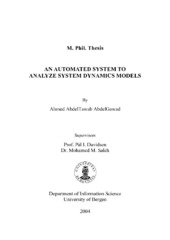An automated system to analyze system dynamics model
Master thesis

Åpne
Permanent lenke
http://hdl.handle.net/1956/15673Utgivelsesdato
2004Metadata
Vis full innførselSamlinger
Sammendrag
For a very long time, software oriented to analyze system dynamics models using eigenvalue analysis technique was not more than a dream. System Dynamics has been hampered by the lack of such software used to analyze the relationship between the structure and behavior in complex, dynamic models automatically. In this thesis, An A to Z mathematical background has been developed, based on Control Theory literature as well as the previous work in the filed of applying eigenvalue analysis to the system dynamics models*, this is in addition to the development of a Matlab code to automate the examination process of the structural origin of different modes of behavior exhibited by a system dynamics model using mathematical method crystallized in the mathematical background. This method allows for an investigation of how model behavior is created from the underlying model structure and how this behavior feeds back to change the relative significance of the model behavior. They also allow us to identify the dynamics of relative significance of the various parameters that governs the gains of the links and loops of the model. By automating this method into Matlab code, System Dynamists have the luxury of behavior to structure identification in a fast and an accurate way that can be further implemented as a part of the simulation package to make the analysis an intermediate process through the modeling process.